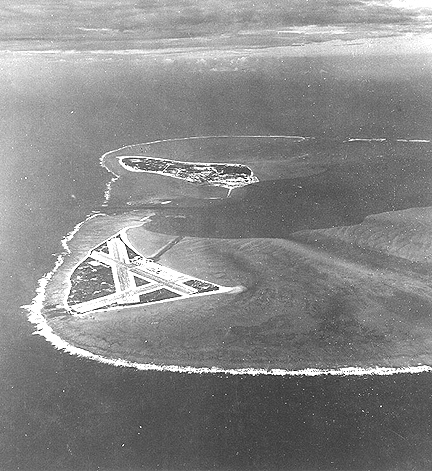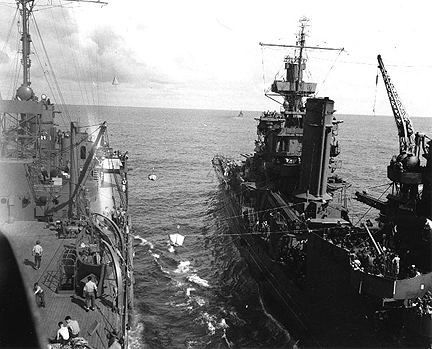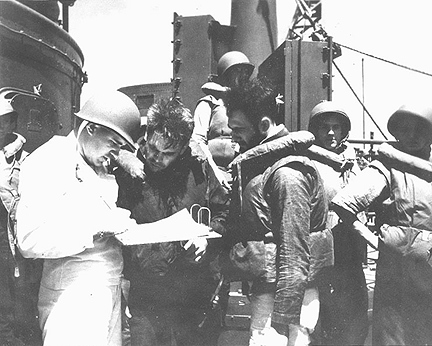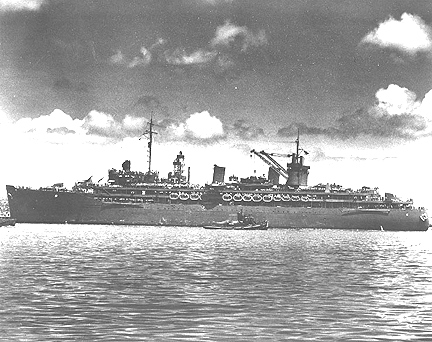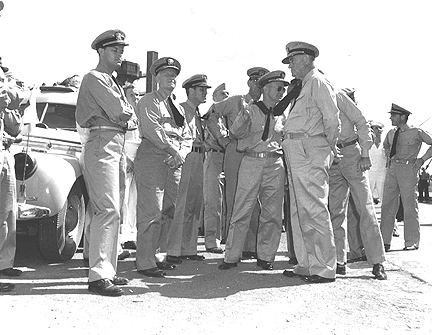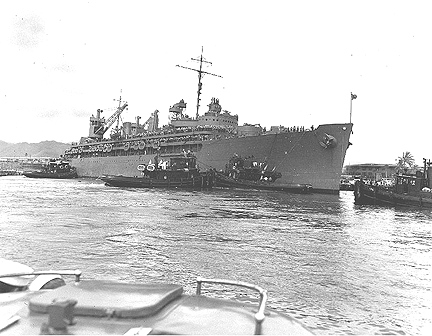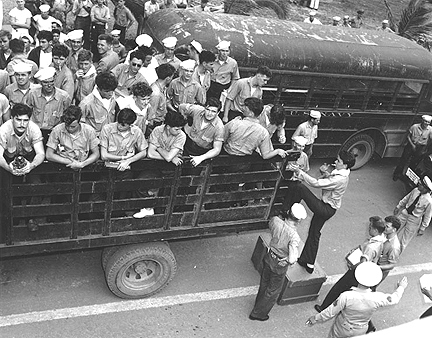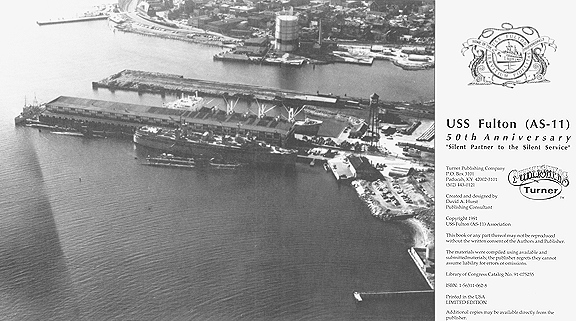| Date | Event |
| 19 July 1939 | Keel for the USS Fulton (AS 11) was laid, at the Mare Island Navy Yard in Vallejo, California. The fourth U. S. Ship to be named in honor of inventor and ship designer ROBERT Fulton. |
|
|
| 27 December 1940 | Fulton was launched under the sponsorship of Mrs. Arthur T. Sutcliffe, great-granddaughter of Robert Fulton. |
|
|
| 12 September 1941 | Fulton Commissioned at Mare Island Navy Yard, California. |
|
|
| 16 October 1941 | Fulton passes under the Golden Gate Bridge at 1304 hours and noses out into the Pacific for builders' trials on her virgin voyage. |
|
|
| 22 November 1941 | Fulton puts to sea, heading South, stops at San Diego on 25 November 1941 |
|
|
| 1 December 1941 | Fulton gets underway from San Diego in a dense fog. The fog lifts, a destroyer is aground but the Fulton is well clear. She noses out to sea and turns her bow Southward for Balboa, Panama Canal Zone on her Shakedown Cruise |
|
|
| 7 December 1941 | Japanese Attack Pearl Harbor, Hawaii: Fulton goes to General Quarters after receiving the word at 1345 hours that there was an air raid on Pearl Harbor, Fulton strips for action and starts zig-zagging. "This is no drill", extra lookouts posted, every merchant ship a potential "Jap!" The silence that followed the announcement was deafening, all the crew exclaimed "Just show us the Japs" |
|
|
| 10 December 1941 | Japanese captures Guam |
|
|
| 23 December 1941 | Wake Island falls to Japanese forces |
|
|
| 12 December through 27 January 1942 | Fulton is assigned various missions of building advanced sea plane bases in Central America and on a Pacific Island near the Equator: Davey Jones come back aboard after giving us a reprieve from when we first passed over the line on January 21st and with proper ceremony, Pollywogs became Shellbacks on 27 January 1942 |
|
|
| 31 December 1941 at Pearl Harbor, Hawaii | At 1000 hours Admiral Chester W. Nimitz assumes command of the U. S. Pacific Fleet, Aboard the Submarine USS Grayling an appropriate setting in view of his long background as a submariner. |
|
|
| Late December 1941 | Isoroku Yamamoto, Commander-in-Chief of Japan's Combined Fleet, stated "We should occupy Midway" |
|
|
| 11 January 1942 | USS Saratoga torpedoed and goes to Bremerton for repairs. |
|
|
| 1 - 14th January 1942 | Japanese Admirals complete plans and sketch, including the attack and occupation of Midway Island. As the plan developed, the operation had a two fold aim: First to occupy the atoll and convert it into a Japanese Air Base and jumping off place for an invasion of Hawaii; second to lure the U. S. Pacific Fleet into the Midway area for a knock-down, drag- out fight which would finish it off |
|
|
| 31 January 1942 | Fulton leaves Central America and heads for the States. |
|
|
| 9 February 1942 | Fulton arrives in San Diego, CA. And ties up at the Broadway Piers, Commander of Submarine Squadron EIGHT moves his flag aboard. |
|
|
| 13 February 1942 | Fulton receives a draft of 300 new recruits straight out of Boot Camp. I was a member of that group, I had enlisted only 43 days ago, on 1 January 1942. I was slated for submarine duty, but was sent to the pipe and copper shop until I received some training. |
|
|
| 15 February 1942 | Singapore surrenders to the Japanese. |
|
|
| 1-28 February 1942 | Japanese victories continue to mount; with the landings at Rabaul, Java Sea battle victories, sinking of the old carrier USS Langley, and the cruiser USS Houston, the loss of the British battleship HMS Prince of Wales and battle cruiser HMS Repulse, and air raids on Darwin in northern Australia. U. S. carrier forces and submarines continued to fight with limited success. |
|
|
| 8 March 1942 | Fulton joins a convoy and heads for Pearl Harbor Hawaii |
|
|
| 13 March 1942 | Fulton enters Pearl Harbor, Hawaii and we view the results of the blitz; sunken ships, some capsized and others still smoldering, the whole harbor was covered with oil, it was a sight and smell none of us will ever forget. |
|
|
| 16 March 1942 | Fulton receives it's first submarine alongside, The USS Drum (SS-228): I had never seen a submarine before, she looked sleek and deadly, I could hardly wait to go aboard her. |
|
|
| All of March 1942 | Japanese plans on Midway attack are firmed up. |
|
|
| 2-5 April 1942 | Japan's High Command (Premier Hideki Tojo) approve of Midway attack |
|
|
| 5 April 1942 | Japanese sink two British Cruisers in Colombo |
|
|
| 9 April 1942 | Japanese sink British carrier HMS Hermes and destroyer HMS Vampire at Trincomalee, Ceylon |
|
|
| 18 April 1942 | Lieutenant Colonel James (Jimmy) Doolittle, and 16 B-25 bombers flew off the aircraft carrier USS Hornet and bombed Tokyo, Yokohama, and other Japanese cities |
|
|
| All of April 1942 | Fulton continues to support and refit submarines for their mission against Japanese merchant and war ships. Fulton furnishes working parties to assist on unloading ammunition etc., from sunken battleships, and relieving navy base shop workers by taking over several repair shops on nights and weekends. |
|
|
| 28-29 April 1942 | Admiral Yamamoto, holds Midway attack strategy meeting aboard his flagship Yamato |
|
|
| 29 April 1942 | Nimitz advises CINCPAC, Admiral Ernest J. King, of Midway situation as follows: "Defenses Midway [break] Consider island at present able to withstand moderate attack but would require fleet assistance forward against major attck[break] will give full consideration to such strengthening and development as may be practicable" |
|
|
| March & April 1942 | Nimitz and his Combined Fleet Staff were diligent in attempting to predict the Japanese next targets and thus circumvent them. Commander Joseph Rocheford, chief of the Combat Intelligence Office familiarly know as "Hypo" headed the Pearl Harbor based cryptanalysis section of Navy intelligence, they worked to break the Japanese code "JN25". Their team could read parts of each Japanese message. |
|
|
| 1- 4 May 1942 | Japanese forces conduct preliminary war games for Midway attack. |
|
|
| 2 May 1942 | Nimitz inspects Midway defenses. |
|
|
| 5 May 1942 | Japanese Admiral Nagano orders Midway and Aleutians operations. |
|
|
| All of May 1942 | Fulton continues to service submarines, as ship's force carrying out routine upkeep and training. As a potential submarine crewmember I was sent to the Diving Tower and qualified for escaping from a sunken sub. Daily we had frequent dispatches to take condition of "Readiness One for Action", so we go to General Quarters and man all the guns. During this time Fulton is also modified and recieves upgraded armament, replacing 50-caliber machine-guns with 20-MM guns. Work ashore on sunken battle ships continue, 16 & 18 hour days are the normal, we sleep in the shops aboard Fulton, as the work goes on. |
|
|
| 6 May 1942 | Corregidor surrenders to the Japanese. |
|
|
| 7 - 11 May 1942 | Battle of the Coral Sea; USS Lexington sunk, USS Yorktown (CV-5) damaged. Two Japanese carriers hit, (Shoho sunk and Shokaku damaged.) [Lexington actually sunk on 8 May] |
|
|
| 10 May 1942 | Midway Island sent a fake message that they were short of water. (This was a trap message to confirm the Japanese main target was Midway Island) |
|
|
| 12 May 1942 | Navy Intelligence [Hypo] intercepts a Japanese message that "AF" (Japanese code name for Midway) is short of water, and through this "innocent" message - falll into the trap that confirms that Miday is in fact "AF" and is the target of their planned invasion. |
|
|
| 15 May 1942 | Nimitz orders Halsey's task force to Pearl Harbor |
|
|
| 17 May 1942 | The submarine USS Triton (SS 201) torpedoed and sank the Japanese submarine I-164 while it was on the surface off Kyushu. |
|
|
| 17 May 1942 | Nimitz orders North Pacific Task force to the Aleutians consisting of heavy and light cruisers and destroyers with support vessels |
|
|
| 18 May 1942 | 7th Army Air Force placed on special "Alert" new B-17s begin to arrive in Hawaii from mainland. |
|
|
| 18 May 1942 | At 1347 hours Fulton again goes to G. Q. - ready for action, all guns manned; and preparations for getting underway made. |
|
|
| 20th-21st May 1942 | Japanese's Midway attack and occupying forces sortie from Japan and rendezvous for exercises at sea and also some forces meet at Saipan. American forces on Midway Islands are on full alert ... General George Marshall flew to the West Coast, fearing the Japanese would very soon strike the southern areas in reprisal for the Doolittle raid on Tokyo |
|
|
| 22 May 1942 | Demolition charges tripped and blow up Midways gasoline dump. |
|
|
| 22-26 May 1942 | Reinforcements poor into Midway. U. S. intelligence intercepts Japanese message indicating "D" Day for attack was 3 June 1942. |
|
|
| 26 May 1942 | U S Aircraft Carriers Enterprise and Hornet arrive in Pearl Harbor. Admiral Halsey too ill to command the operation and he recommends Spruance to take over command. |
|
|
| 27 May 1942 | Japanese forces sortie toward Midway. The U. S. carriers Enterprise and Hornet are refurbished and remanned. At 1352 , The damaged aircraft carrier Yorktown enters Pearl Harbor for repairs. Fulton crew observes the Yorktown and her damage as they nudge her into berth 16. It was estimated that it would take 3 months to put Yorktown back in prime fighting condition, but the circumstances directed it would take a minimum of about two to three weeks.... |
|
|
| 28 May 1942 | Task Force 16 (Enterprise and Hornet, with support ships leave Pearl Harbor) head to sea with Admiral Spruance in command to await Japanese attack forces off Midway. |
|
|
| 28 May 1942 | Admiral Fletcher named commander of U. S. Task Forces for Midway operations (His flag is aboard USS Yorktown). Yorktown moved from Berth 16 to Dry Dock #1 at 0645 |
|
|
| 29 May 1942 | Midway receives additional Army Air Force bombers and crews (B-17 and B-26s) Commander Logan C. Ramsey was sent to Midway to co-ordinate all air operations. |
|
|
| 30 May 1942 | Japanese submarine I-123 find U. S. Ships at French Frigate Shoals, which they had planned to use as a base for their seaplanes. Operation "K" postponed. NOTE: This was a flying boat mission intended to furnish the Japanese with intelligence on the U S Pacific Fleet positions. The submarine was to refuel the flying boats at French Frigate Shoals. |
|
|
| 30 May 1942 | Task Force 17 sorties from Pearl Harbor, Yorktown, (hastily repaired in less than 48 hours) supported by the heavy cruisers Astoria and Portland and destroyers Hammann, Hughes, Morris, Anderson and Russell. |
|
|
| 31 May 1942 | The Stage was set: Towards Midway ----- two tiny specks almost invisible on a map of the Pacific ---- raced the sea power of the United States of America and Empire of Japan. With the ships rode the intangibles. Would the Japanese with their superior tonnage and firepower and habit of victory succeed in another convincing victory? ... Or would the U. S. Navy, out manned and out gunned, but with surprise, flexibility, naval intelligence and a grit determination to stop the Japanese victory parade be enough for a convincing United States Victory. |
| 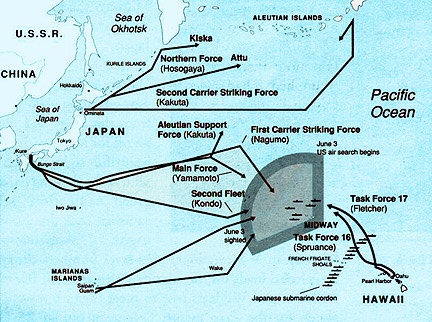 |
| Movements of the various fleets. The Japanese deployed a total of ten task forces -- any one of which was a serious threat to both of the task forces sent by the Americans (the tenth "force" from the Japanese side was the submarine cordon line stretched between Hawaii and Midway. Had that line intercepted either task force leaving Hawaii - the results would have undoubtedly been much different. |
|
|
| 31 May 1942 | Fulton crew senses emergency, all liberty is cancelled until further notice |
|
|
| 1 June 1942 | Japanese midget submarine penetrates Sydney Australia harbor and fires torpedo at U. S. Cruiser Chicago, missing it but hitting ferry boat being used as barrack-ship for sailors killing a number of them. All three Japanese Midget Submarines involved were sunk. |
|
|
| 1 June 1942 | Fulton continues her daily routine, voyage repairs to submarines, and training. The crew observed the departing of fleet units, and a sense of caution that existed in the port area, what we didn't know was that a major battle was shaping up for the control of the Midway Islands. |
| Date | Time | Event |
| 2 June 1942 | 1023 | Fulton shifts berths, to pier S-13, Submarine Base, Pearl Harbor, T. H. Moored Port side to. |
| |
|
| 2 June 1942 | 1600 | U. S. Task Forces 16 (Enterprise & Hornet) and 17 (Yorktown) rendezvoused at designated spot named "Point Luck" (32° North Latitude, 173° West longitude, about 325 miles northwest of Midway) |
| |
|
| 2 June 1942 | | Japanese positioned two cordons of submarines between Midway and Pearl Harbor for surveillance and to attack any fleet vessels that may attempt to join the battle for Midway Island. |
| |
|
| 3 June 1942 | 0700 | Japanese 2nd Carrier Striking Force attack Dutch Harbor: "AO" (Japanese code name for Aleutians) is the main target of Japan's diversionary thrust against the lonely Aleutians. |
| |
|
| 3 June 1942 | 0900 | Japanese escort forces spot U. S. planes flying search missions from Midway. Jack Reed in a PBY had spotted elements of the Japanese Invasion force, 700 miles from Midway. |
| |
|
| 3 June 1942 | 1228 | Midway B-17s take off to strike Japanese force. |
| |
|
| 3 June 1942 | 1640 | B-17s attack Japanese Transport group; no hits. |
| |
|
| 3 June 1942 | 2115 | 4 PBYs with torpedoes attached to their wings take off from Midway to make a night attack on Japanese forces. |
| |
|
| 4 June 1942 | 0245 | PBYs (Catalinas) report attack completed on Japanese Transport group, one hit reported; no sinkings. |
| |
|
| 0400 | Midway sends out search planes, and B-17s to attack the Japanese Transport group, also protective cover aircraft for the island |
| |
|
| 0430 | Japanese begin launching attack aircraft towards Midway. From the carriers Akagi, Kaga, Soryu, and Hiryu respectively, they launched 108 planes consisting of Zero fighters, dive bombers and straight bombers. |
| |
|
| 0530 | Air crews alerted on Midway, they waited and they watched. |
| |
|
| 0530 | Reveille aboard Fulton, another routine day, we continue voyage repairs to submarines alongside, ships force carrying out routine upkeep and training. No hint of the major battle that is just starting for the Midway Islands. |
| |
|
4 June 1942
Aboard
USS Enterprise | 0534-0645 | Enterprise receives a report on a Japanese carrier; Midway aircraft scramble aloft to meet the Japanese, out numbered and unable to match the attack capabilities of the Zero fighters, the Navy and Marine pilots shoot down and damage several of the bombers,. The Japanese continued on their mission to knock out the air defense on Midway, Sand and Eastern Island. The air battle was fierce and our losses heavy. |
| |
|
4 June 1942
The
Battle
for
Midway | 0630-0643 | Midway defenders ordered to open fire when Japanese planes are within range. The PT boats were underway in the lagoon, their machine guns and even rifles and pistols at the alert. The level bombers reached Midway first and concentrated on Sand Island.. Anti-Aircraft (AA) fire brought down two of the attacking bombers. Fuel tanks on the Northeast end of the island suffered a direct hit. AA guns were knocked out. On Eastern Island, the hanger was hit, the power house was demolished knocking off all electricity and the water distillation plant. Fuel lines between the dock area and the main gas storage areas were destroyed, now all planes had to be fueled from drums of gas via hand pumps. The marine mess hall and post exchange were hit and knocked out. The Navy Dispensary, clearly marked with a big red cross on the roof was completely demolished along with the laundry. After the bombers had left the zeros came in strafing the area. |
| |
|
| 0643-0700 | Japanese end the 1st attacks on Midway Islands and start their return to their carriers. They lost 8 bombers and 3 Zeros, with a number of bombers and Zeros damaged. American losses were worse, fourteen pilots lost out of 26, and only two of the fighter aircraft were fit to fly again. 20 men were killed on the ground. A Japanese pilot reports "There is need for second attack". Midway defenders had done their gallant if not very effective best. |
| |
|
| 0700-0707 | USS Hornet and USS Enterprise launch a total of 116 aircraft for a coordinated strike of torpedo and dive bombers with fighter escort towards the Japanese carriers some 200 miles away. |
| |
|
| 0710-0755 | Midway Navy, Marine and Army planes attack Japanese carriers, the garrison had launched a determined, gallant but futile attack with no tangible results, and many planes lost. |
| |
|
| (4 June 1942) | 0800 | USS Nautilus attacks Mobile Force, no hits. Depth-charged repeatedly |
| |
|
| 0820-0918 | Japanese Admiral receives report of American task force that includes carriers; his carriers Hiryu and Soryu had total of 36 dive bombers on deck, and the Akagi and Kaga had torpedo bombers with land bombs, all ready for a second attack on Midway. His Zeros were in the air and needed to be landed, rearmed and refueled. A decision was made to change from bombs to torpedoes for attacking the American carrier forces. The USS Yorktown (CV-5) at this time began launching her aircraft: All returning Japanese aircraft land aboard the carriers. All planes will be refueled and rearmed and ready to attack U. S. Forces around 1100. Reports received from his scout plane "10 enemy (U.S.) torpedo planes are heading towards you". |
| |
|
| 0955-1022 | USS Enterprise's SBDs (32 Dauntles Dive Bombers) spot the Japanese Mobile Force. Initial contact for attack was the carriers Akagi and Kaga. Kaga was hit by bombs, squarely amidst the planes massed for take off, instantly the flight deck was a holocaust. Additional bomb hits in the vicinity of the forward elevator exploded in the hanger deck causing the fully armed and fueled planes that were ready for the next attack on Midway Island to explode, the ship was doomed and abandon ship was sounded. |
| |
|
| 1022-1042 | Lt. Richard H. Best led his 5 SBDs against the Japanese carrier Akagi, dropping bombs on the flight deck as the carrier was attempting to launch fighter (Zeros) aircraft. The bombs were fused to penetrate the flight deck and explode in the hanger deck.. The Enterprise dive bombers had caught the Akagi with her flight deck full of armed and fueled aircraft; plus, bombs destined for Midway that had been removed so torpedoes could be installed for the attack on the U S Task forces, had not been returned to storage. The induced explosions of planes, fuel and armament doomed the Akagi, and turned her into "a burning hell". |
| |
|
| 1025 | USS Yorktown planes start bombing runs against Soryu, she was hit several times and bombs exploded in her hanger deck fires enveloped the whole ship in no time. Exactly half an hour had passed from the first hit on Soryu until "Abandon Ship" was sounded. Thirty short minutes had transformed Soryu from a smart, proud carrier -- to a burned-out crematorium. The dive bombers had accomplished in a matter of minutes what the preceding attack waves had failed to do in 3 hours. The torpedo bombers had failed to dent a single Japanese ship. |
| |
|
| 1150 | The U. S. dive-bombers did not escape unscathed. The Yorktown group was the most fortunate- no one was lost in this action. Enterprise was not so lucky, she had lost fourteen dive bombers, of which a number had to ditch at sea for lack of gas. |
| |
|
| (4 June 1942) | 1200 | As the Yorktown planes returned to their ship they received a wave-off, Yorktown was under attack. Support vessels were ordered to assume Victor formation against the air attack, the heavy cruisers Astoria and Portland on Yorktown's port and starboard bow with the destroyers setting up an outer screen.. Damage control parties were on station, all guns manned, and 12 Wildcat fighters were sent aloft to meet the incoming Japanese bombers and fighters. At about 15 miles out the USS Yorktown planes, assisted by 6 planes from the USS Enterprise tangle with the Japanese Zero fighters and bombers. Before the enemy planes could reach Yorktown 10 of their planes had been shot down. |
| |
|
| 1201 | Yorktown's gunners took up their ships defense, shooting down several dive bombers as they dove on the ship, but their bombs fell on the Yorktown's deck, killing or wounding over 36 men. A hole ten feet square was blown in the center of the flight deck, fires were started in planes on the hanger deck. Fires from a bomb with a delayed action fuse exploded in the Yorktown's stack, snuffing out fires in her boilers, and causing her speed to drop to about 6 knots. |
| |
|
| 1220 | Yorktown at a dead standstill, her damage control crews continue fighting fires and repairing the damage from the 3 bomb hits. Carpenters rushed to the flight deck and with their know-how and determination had the flight deck usable within 25 minutes. The boiler room crew ignoring the searing heat and choking fumes and constant danger of being blown to bits, soon (1 hour and 20 minutes after the breakdown flag was hoisted) worked up sufficient steam to get her underway again. |
| |
|
| 1313 | Admiral Fletcher realizing the damaged Yorktown was no longer practical to serve as his flagship decided to remove his flag to the heavy cruiser Astoria. The staff sliding down manila lines into the Astoria's #2 whale boat, and Admiral Fletcher lowered by two seamen into the boat. Immediately upon arriving aboard the Astoria, Fletcher informed Admiral Nimitz of the situation; CINCPAC dispatched to the scene the minesweeper Vireo from Hermes Reef and the fleet tug Navajo from French Frigate Shoals. He also diverted the destroyer Gwin, already a day out of Pearl Harbor en route to join Spruance, to augment Yorktown's guard. |
| |
|
| 1437 | Yorktown built up enough speed to make a respectable 19 knots. A spontaneous cheer rang out from every ship in the carriers screening forces. Yorktown was still alive. |
| |
|
| 1443-1454 | Planes from the Japanese carrier Hiryu, attack the Yorktown for a second time, and score two torpedo hits on her port side piercing the port fuel tanks, flooded three fire rooms and the forward generator room - cutting off all electrical power. A short in the control board blocked off the emergency generators. Her rudder jammed for the second time that afternoon. Yorktown stopped in her tracks and tilted to a 17° list to port. Within about ten minutes after the torpedoes struck she was leaning 26°. |
| | 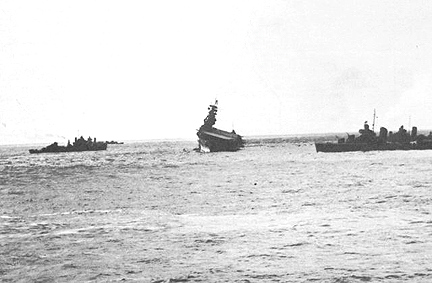 |
| |
|
4 June 1942
USS Hornet | | Hornet had experienced a tragic and frustrating day. She had lost all her torpedo bombers; her dive-bombers had missed the action entirely; and her fighters ditched for lack of fuel. And while playing good Samaritan to refugee planes from the Yorktown a wounded pilot crashed his Wildcat without cutting off his machine guns, the impact sprayed slugs into the carriers island killing five men and wounding twenty. The killed included the son of the Commander in Chief of the Atlantic Fleet, Admiral Ingersoll. |
| |
|
4 June 1942
USS Yorktown | 1455 | With all power and communications lost, the ship healing over to where her flight deck almost touched the water. Her ruptured fuel tanks spreading a deadly oil film around the ship that even a small spark would ignite and turn it into a sheet of flame, Captain Buckmaster, orders the 3000 men aboard to abandon ship. Yorktown was a dead loss as an aircraft carrier. Her only remaining assets were the men aboard her. The blue and white signal flag was hoisted; "Abandoning Ship": The USS Balch (DD- 363), Benham, Russell, and Anderson (Destroyers) closed in to pick up the evacuees, while others established an anti submarine screen. The removal of Yorktown's wounded was very difficult because of the ships list and slippery decks. By various means the wounded were lowered gently or carried bodily to the rescue ships. Sailors from the other ships dived in the water to assist those unable to swim. Cargo nets, life rafts, and motor boats all played their part. Captain Buckmaster made an inspection of the ship before he also abandoned her, he went aboard a life raft and was later picked up by the destroyer Hammann and thence to the cruiser Astoria. |
| |
|
| 1445-1550 | The Japanese carrier Hiryu was located by U S scout planes, Admiral Spruance immediately ordered aloft all airworthy attack aircraft, some armed with 1000# bombs others with 500# bombs. |
| |
|
| 1645 | U S Planes from Enterprise and Yorktown (flying from Enterprise) sight the Japanese carrier Hiryu. |
| |
|
| 1701-1705 | U. S. Planes attack Hiryu, she is hit by four bombs in rapid succession, fires spread throughout the ship. Burning from bow to stern she was still running at high speed like a mad bull. |
| |
|
| 1707 | Planes from the Hornet join the attack on other ships, No hits. |
| |
|
| 1745 | B-17s from Midway Island attack other Japanese ships, same results as earlier in the day. No hits. |
| |
|
| 1750-2000 | Japanese carriers Kaga and Soryu are sunk, while all hands abandon the sinking Akagi. |
| |
|
| 2015 | The USS Fulton received verbal instructions from the Commander Submarines Pacific Fleet to prepare to get underway as soon as possible. As I recall, we were totaly unaware that a major battle had been taking place just off Midway Island. The crew was watching the movie "Sergeant York", on the boat deck when the word was passed, and the movie stopped. All hands prepared the ship for sea. |
| |
|
| 2204 | The USS Fulton was underway, in compliance with CINCPAC dispatch of 4 June, and stood out of Pearl Harbor. The USS Breese (DM- 18) and USS Allen (DD-66) joined as escorts. Proceeded to northwestward, zigzagging at seventeen knots speed, towards prescribed rendezvous with undesignated vessels of Task Force 16 and Task Force 17 who are to transfer excess personnel on board (survivors of Midway battle) to Fulton for transportation to Pearl Harbor. Expect to make rendezvous in forenoon six June. |
| |
|
| 5 June 1942 | 0130 | The Japanese submarine I-168 fires on Midway Island, no damage. Shortly thereafter the I-168 is ordered to sink a U. S. carrier 150 miles away. |
| |
|
| 0200 | The USS Fulton, continues on her mission of mercy, transversing through the cordon of 16 Japanese submarines stationed northwest of Hawaii to intercept any fleet units that would be sent to support the defense of Midway. |
| |
|
| 0230 | Abandon Ship is ordered aboard the Japanese aircraft carrier Hiryu. |
| |
|
| 0255 | Japanese Admiral Isoroku Yamamoto, Commander in Chief of the Combined Fleet, calls off the operation against Midway. It was necessary to completely reorient themselves from an attitude of "How far reaching will our victory be" to "How much can we salvage". |
| |
|
| 0430 | Evacuation of Hiryu completed. |
| |
|
| 0500 | Japanese carrier Akagi scuttled. |
| |
|
| 0510 | Japanese destroyer torpedoes Hiryu. |
| |
|
| 0600-0850 | U. S. patrol planes spot 2 battleships 1 heavy cruiser and 3 light cruisers, U. S. bombers (B-17s) attack a cruiser. As daylight had just begun, destroyers screening the damaged and abandoned Yorktown were startled to hear a rattle of machine gun fire from her. The destroyer Hughes sent a detachment to the carrier to investigate. Much to their surprise, they found a S2/c badly wounded, who had fired the machine gun, and he informed them that another sailor, left for dead was alive in sickbay. Both men were returned to the destroyer. |
| |
|
5 June 1942
USS Fulton | 0800 | The Fulton's position: Latitude 22° 43' N. Longitude 159° 33'W. The crew prepares equipment and resources to take aboard battle survivors, many of them wounded. |
| |
|
| 0900 | Japanese carrier Hiryu sinks. |
| |
|
| 1200 | Fulton position: Latitude 23° 12' N. Longitude 160° 30' W. |
| |
|
5 June 1942
USS Astoria | 1430 | While Captain Buckmaster was assembling a salvage party aboard the cruiser Astoria, his hand picked group of 24 officers and 145 men would board the destroyer Hammann that later would return to the Yorktown. |
| |
|
5 June 1942
Vicinity
Midway Island | 1435 | B-17 bombers from Midway Island, sent out to bomb elements of the Japanese fleet, found no carriers but reported attacking other ships. |
| |
|
5 June 1942
USS Yorktown | 1436 | U. S. Navy minesweeper Vireo began to pull Yorktown at a barely perceptible two knots. The destroyer Gwin appeared and assumed command of salvage operations. The destroyer Hughes and Gwin sent boarding parties aboard the Yorktown and worked rapidly to throw overboard everything they could from the listing side of the ship. Little could be done as darkness approached and the Yorktown had neither power nor light. |
| |
|
| 1545-
after dark | Enterprise and Hornet begin launching 58 bombers to finish of the Japanese carrier, but found nothing but a lone Japanese destroyer Tanikaze. No hits, lots of near misses. planes return to carriers, and Admiral Spruance orders search lights turned on as beacons to assist returning planes find the ship. 1 plane was lost to AA fire and one plane was lost, running out of gas trying to land. |
| |
|
| 2000 | Fulton continues on her mercy mission, position: Latitude 24° 13' N. Longitude 162° 41'W. |
| |
|
| 2320 | The Japanese transfer wounded survivors to Battle ships. |
| |
|
| 6 June 1942 | 0200 | Over twenty-four hours after she had been abandoned, with the minesweeper Vireo towing her, before daybreak Hammann secures to Yorktown's starboard side, transferred the salvage party and provided power, pumps and water for their work. Captain Buckmaster and his men worked like beavers. They quenched the one remaining fire, corrected the list by counter flooding with the aid of Hammann electrical power and pumps, jettisoned planes and removed weights from the port side and had made considerable progress by mid afternoon. |
| |
|
| 6 June 1942 | 0410 | The Japanese submarine I-168, that had shelled Midway earlier, and been ordered to go get the Yorktown, spots her in the distance at 20,000 meters (approximately twelve miles). |
| |
|
| 0502 | Enterprise launches aircraft in search of Japanese battleships, cruisers and destroyers. |
| |
|
| 0645 | Enterprise planes spot what were thought to be battleships and cruisers, actually it turned out to be two crippled cruisers and two destroyer escorting them. |
| |
|
| 0759 | Hornet launches 26 dive-bombers and 8 fighters to attack the Japanese cruisers and destroyers. |
| |
|
| 0800 | Fulton closes in on Yorktown Task Force, position: Latitude 25° 44'N. Longitude 165° 52' W. |
| |
|
| 0945 | Hornet planes attack and make hits on 3 Japanese ships. |
| |
|
| 1045 | Enterprise launches 31 dive-bombers and 12 fighters, Midway sends out 26 B-17s after the cruisers. The B-17s fail to find cruisers but spot the U. S. Submarine Grayling (thinking she was a Japanese cruiser) and bomb her with over 20, 1000 pound bombs and reported her sinking in 15 seconds. The sub skipper surfaced later and reported the incident to headquarters, and wanted to know why an American Submarine had to crash dive to avoid being bombed by the Army Air Force.??? |
| |
|
| 1200 | Fulton's position: Latitude 26° 18'N., Longitude 166° 57' W. Course and distance made good since 1200 June 5, course 298° true; distance 393 miles (remember we were zig-zagging) average speed 16.3 knots. |
| |
|
| 1230 | Enterprise planes score hits on both cruisers. |
| |
|
| 1237 | Sighting of the Yorktown group rewarded the Japanese skipper's of the submarine I-168s pertinacity. He skillfully penetrated the U. S. destroyer and cruiser anti-submarine screen undetected. He was within 500 meters, and inside the destroyer's screen. As he raised his periscope the Yorktown loomed over him like a mountain, he could clearly see the faces of men aboard her. He was too close for comfort and too close for a torpedo attack. He was forced to move back for a more favorable point to attack from. As he moved into his turn he discovered all sounds of enemy detection activities had disappeared. (The captain and his navigator assumed the U. S. Destroyer sonar men had gone off to lunch; {[ED. CJM] I wonder if that could have been so????}) allowing the I-168 to move back under the screen for a distance of 1200 meters. |
| |
|
| 6 June 1942 | 1300 | USS Fulton meets the USS Portland, USS Morris and USS Russell at Latitude 26° 26' N., Longitude 167° 13'W. Steamed on various courses and speeds preparatory to towing alongside Portland to transfer survivors of the Yorktown to Fulton. The destroyer Allen received survivors from the USS Russell. |
| |
|
| 1331 | The Japanese submarine fires 4 torpedoes at the crippled Yorktown. The first one hit the destroyer Hammann amidships (she was tied up to the carriers starboard side.) blasting the destroyer almost in half, she sank in about 3 minutes, with the loss of many of her crew. As she plunged down her depth charges exploded at three different levels. Nine of the Hammann 13 officers were killed and seventy-two of her crew of 228. |
| | 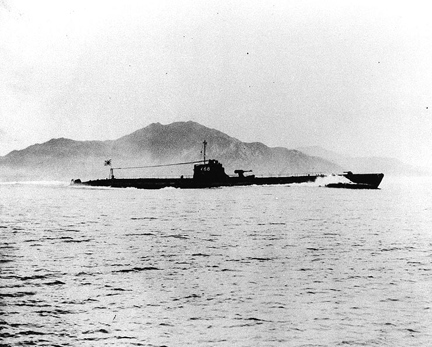 |
| | The I168 - pictured here in March 1934- probably on Sea Trials. At this time she was known as the I68 - but was renamed the I168 in May 1942. Photo donated by Kazutashi Hando in 1970 to the U. S. Naval Archives. |
| |
|
| 1332 | The next two torpedoes struck the Yorktown at frame 85 starboard at the turn of the bridge, knocking a huge hole in the hull. The forth torpedo was off target, passing the carrier just astern.. Yorktown's No. 3 Auxiliary elevator pulled loose, various fixtures crashed to the hanger deck. All rivets in the starboard leg of the foremast sheared. Men were thrown every which way, some overboard entirely, others incurring broken bones, cuts and bruises. |
| |
|
| 1336-1640 | Within 5 minutes of torpedoing the Yorktown, I-168 undergoes severe depth charge attack, he goes towards the carrier, thinking the U. S. destroyers would not drop depth charges in an area that would kill any survivors in the water. Over 60 depth charges were dropped around them.. A destroyer passed directly over them and dropped two depth charges that severely damaged the I-168. The sub's lights went out, emergency lights came on, flooding in the forward torpedo compartment, and after steering rudder engine room. Quick work of the crew patched the flooding. As sulfuric acid leaked from damaged batteries and mixed with the salt water in the bilges to form chlorine gas, breathing became more and more difficult. Both horizontal and vertical rudders were out of commission. Sunset was in two hours, the captain rallied his men to stick it out till then. Finally the ship had to rise, the crew prepared for battle surface, determined to go down fighting. When they surfaced, to their amazement nothing was in sight nearby, 3 enemy destroyers were about 10,000 meters away, but no carrier in sight, they assumed she (Yorktown) had been sunk.. The I-168 had survived. |
